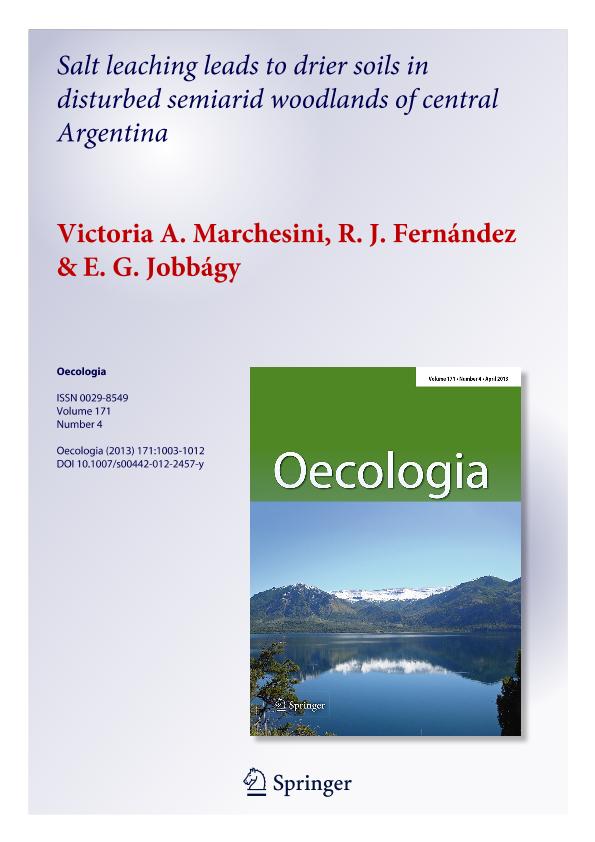Mostrar el registro sencillo del ítem
dc.contributor.author
Marchesini, Victoria Angela
dc.contributor.author
Fernandez, Roberto Julio
dc.contributor.author
Jobbagy Gampel, Esteban Gabriel

dc.date.available
2016-02-16T20:14:04Z
dc.date.issued
2013-04
dc.identifier.citation
Marchesini, Victoria Angela; Fernandez, Roberto Julio; Jobbagy Gampel, Esteban Gabriel; Salt leaching leads to drier soils in disturbed semiarid woodlands of Central Argentina; Springer; Oecologia; 171; 4; 4-2013; 1003-1012
dc.identifier.issn
0029-8549
dc.identifier.uri
http://hdl.handle.net/11336/4229
dc.description.abstract
Disturbances in semiarid environments have revealed a strong connection between water, salt and<br />vegetation dynamics highlighting how the alteration of water fluxes can drive salt redistribution process and longterm environmental degradation. Here, we explore to what extent the reciprocal effect, that of salt redistribution on water fluxes, may play a role in dictating environmental<br />changes following disturbance in dry woodlands. We assessed salt and water dynamics comparing soil-solution electrical conductivity, chloride concentration, soil water content (SWC) and soil matric and osmotic water potential (Wm, Wos) between disturbed and undisturbed areas. A large pool of salts and chlorides present in undisturbed areas was absent in disturbed plots, suggesting deep leaching. Unexpectedly, this was associated with slight but consistently lower SWC in disturbed versus undisturbed situations during two growing seasons. The apparent paradox of increased leaching but diminishing SWC after disturbance can be explained by the effect of native salt lowering Wos enough to prevent full soil drying. Under disturbed conditions, the onset of deep drainage and salt leaching would raise Wos allowing a decline of Wm and SWC. Soil water storage seems to be modulated by the presence (under natural conditions) and partial leaching (following selective shrub disturbance) of large salt pools. This counterintuitive effect of disturbances may be important in semiarid regions where deep soil salt accumulation is a common feature. Our results highlight the importance of water–salt–vegetation coupling for the understanding and management of these systems.
dc.format
application/pdf
dc.language.iso
eng
dc.publisher
Springer

dc.rights
info:eu-repo/semantics/openAccess
dc.rights.uri
https://creativecommons.org/licenses/by-nc-sa/2.5/ar/
dc.subject
Deforestation
dc.subject
Water Dynamics
dc.subject
Salt Dynamics
dc.subject
Semiarid Woodlands
dc.subject.classification
Ciencias de las Plantas, Botánica

dc.subject.classification
Ciencias Biológicas

dc.subject.classification
CIENCIAS NATURALES Y EXACTAS

dc.subject.classification
Ecología

dc.subject.classification
Ciencias Biológicas

dc.subject.classification
CIENCIAS NATURALES Y EXACTAS

dc.title
Salt leaching leads to drier soils in disturbed semiarid woodlands of Central Argentina
dc.type
info:eu-repo/semantics/article
dc.type
info:ar-repo/semantics/artículo
dc.type
info:eu-repo/semantics/publishedVersion
dc.date.updated
2016-03-30 10:35:44.97925-03
dc.journal.volume
171
dc.journal.number
4
dc.journal.pagination
1003-1012
dc.journal.pais
Alemania

dc.journal.ciudad
Berlin
dc.description.fil
Fil: Marchesini, Victoria Angela. Consejo Nacional de Investigaciones Científicas y Técnicas. Oficina de Coordinación Administrativa Parque Centenario. Instituto de Investigaciones Fisiológicas y Ecológicas Vinculadas a la Agricultura; Argentina
dc.description.fil
Fil: Fernandez, Roberto Julio. Consejo Nacional de Investigaciones Científicas y Técnicas. Oficina de Coordinación Administrativa Parque Centenario. Instituto de Investigaciones Fisiológicas y Ecológicas Vinculadas a la Agricultura; Argentina
dc.description.fil
Fil: Jobbagy Gampel, Esteban Gabriel. Consejo Nacional de Investigaciones Científicas y Técnicas. Centro Científico Tecnológico San Luis. Instituto de Matemática Aplicada de San Luis; Argentina
dc.journal.title
Oecologia

dc.relation.alternativeid
info:eu-repo/semantics/altIdentifier/url/http://link.springer.com/article/10.1007%2Fs00442-012-2457-y
dc.relation.alternativeid
info:eu-repo/semantics/altIdentifier/doi/http://dx.doi.org/10.1007/s00442-012-2457-y
dc.relation.alternativeid
info:eu-repo/semantics/altIdentifier/issn/0029-8549
Archivos asociados
